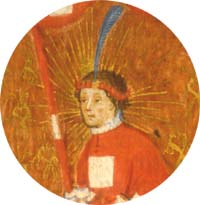| Please note that these pages are from our old (pre-2010) website; the presentation of these pages may now appear outdated and may not always comply with current accessibility guidelines. |
| Please note that these pages are from our old (pre-2010) website; the presentation of these pages may now appear outdated and may not always comply with current accessibility guidelines. |
 |
| The choice for book of the month for February is the Legenda Aurea or Golden legend of Jacobus de Voragine (ca 1228-1298). This collection of saints' lives was used for regular devotional readings in chapter houses and refectories of monastic institutions. It was probably the most popular non-liturgical work of the late Middle Ages; a fact borne out by the 1000 or so surviving manuscripts and the 150 printed editions published before 1550. |
|
|
This codex (since 1987 in two volumes) is, for several reasons, of exceptional importance. The first concerns the content. While the original work comprised 182 lives or tales, linked to important liturgical feasts, this manuscript has been augmented by the inclusion of a further 69 chapters, dealing with saints who lived or were canonized after the author's death; amongst these, emphasis is given to a group from the South Netherlandic. The second is the remarkably rich decoration and illustration. The five main divisions of the text commence with enlarged, decorative letters. In contrast with the French translations of the Legenda the Latin versions are rarely illustrated, whereas in this copy we find no fewer than 102, column-wide miniatures. Besides individual images of saints simply seated or standing, several scenes depict a typical event from a saint's life or martyrdom. Into these the artists have attempted to infuse both variety and vitality by the use deportment, gesture and drapery. On occasion a certain degree of drama has been realised. And by basing their miniatures on the programme supplied by the adjacent texts, the artists often deviate from traditional iconographical convention. |
| Three fifteenth century artists working in a closely related style have been identified by Nicholas Rogers as the Litany Master, the Deacon Master and the Helen Master. Characteristic is the mitred frame surrounding each of the miniatures creating the effect of a real picture frame. In the restricted colour palette blue, red and violet are conspicuous. Through their modelling and handling of colour, the miniaturists display an extraordinary skill in creating a sense of three-dimensionality and facial expression. |
|
|
|
| Stylistically the Helen Master is the most individual of the three. His work is characterised by the white highlighting of the faces and their sharp eyes; the second largest miniature, the Death and Coronation of the Virgin (146v) may be attributed to him. The backgrounds of the miniatures are red or blue with gold patterning. The miniature of saint Anthony (39v) however, places the saint against a background of blue sky growing paler towards the horizon. The presence of this and other naturalistic features suggest experimentation with new ideas, and has caused scholars to regard this manuscript as an important expression of pre-Eckian realism. |
|
|
Although the normal size of the miniatures, some 75 x 65 mm., restricts their scope for including much narrative detail, the artists' work is marked by their concern for the natural appearance of people and for the minutiae of their daily life, exemplified by Joseph preparing gruel in the scene of the Epiphany. |
|
|
|
The additional legends dealing with Flemish
saints, such as Bavo, Livinius, Walburga, Bonifatius, Eligius and
Donatianus are almost all illustrated, and in the last mentioned we
encounter the earliest depiction of the saint holding his distinctive
attribute - a wheel with candles. Donatianus, the patron saint of
Bruges, also points to the likely origin of this manuscript, which bears
marked stylistic similarities to other Bruges productions. |
|
| The month of February is of course
intimately associated in the popular mind with one saint in particular,
Saint Valentine, a third century priest of the Roman church who was
martyred during the persecution of Claudius II, the Goth. His life appears
on fol. 39v, but is unfortunately unillustrated. There is nothing in either
this saint's legend or that of the other saint Valentine, a martyred
bishop of Terni, to account for the custom of choosing a partner and
sending 'valentines' on the 14th February, but seems rather
to have arisen out of the common belief that this was the time when birds
began to pair. As Chaucer mentions in his Parliament of Fowles,
'For this was on Seynt Valentynes day |
Other items of interestAdditional Reading
|
|
Return to main Special Collections Exhibition
Page
|